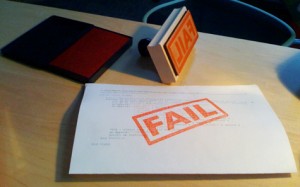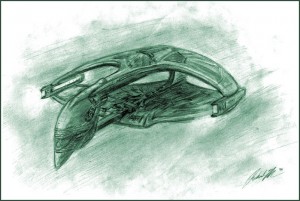ublo
bogdan's (micro)blog
bogdan » proiect. curs fulger
09:05 pm on Feb 13, 2013 | read the article | tags: howto
The word project comes from the Latin word projectum from the Latin verb proicere, “before an action” which in turn comes from pro-, which denotes precedence, something that comes before something else in time (paralleling the Greek ???) and iacere, “to do”. The word “project” thus actually originally meant “before an action”.
— wikipedia
ceea ce scriu în rândurile următoare nu este o rețetă completă, ci mai degrabă un schelet universal pentru structurarea ideilor și pregătirea planului unui proiect (indiferent de tip):
1. alege-ți o idee. încadreaz-o într-un context și găsește-i o justificare pe care o testezi cu prietenii care nu sunt implicați. testul este trecut atunci când aceștia înțeleg clar despre ce e vorba.
2. vezi ce ai putea să măsori în ideea anterioară, de preferat cu cifre și stabilește câte un obiectiv pentru fiecare măsură.
3. detaliază cum poți să atingi fiecare obiectiv, sub forma unui algoritm, cu pași, cu oameni implicați și cu resurse de care ai nevoie.
4. fă un sumar al contribuției oamenilor și unul al necesarului de resurse. vezi de unde poți obține resursele respective.
5. nu uita de cifrele de la punctul 2. găsește o metodă prin care să le poți urmări constant.
6. folosind cifrele de la punctul 2 analizează modul în care implementarea ideii va afecta contextul general în care ai încadrat-o inițial.
7. gândește-te ce vei face când proiectul se va termina. cum poți folosi resursele și experiența rezultate din proiect pentru a obține alte rezultate în direcția care te interesează.
sunt o mulțime de firme care oferă cursuri de management de proiect. majoritatea îți prezintă fix algoritmul de mai sus îmbrăcat în limbaj de lemn, matrice (pronunțate incorect ”matrici”) și abrevieri mnemonice inutile uimindu-te că deși ai fost SMART, proiectul tău nu a fost ales pentru implementare.
sursă foto: www.eci.com

bogdan » prieten sau dușman
11:58 pm on Feb 12, 2013 | read the article | tags: ideas
Lex III: Actioni contrariam semper et æqualem esse reactionem: sive corporum duorum actiones in se mutuo semper esse æquales et in partes contrarias dirigi.
– Isaac Netwon
dușmanii te ajută să își păstrezi direcția. persoane, obiecte reale sau abstracte, dușmanii sunt lentile care concentrează orice efort incident asupra unei singure ținte, fiind printre altele cheia evoluției.
supraviețuirea – păstrarea ordinii naturale are un dușman în tendința universului către dezordine. echilibrul între cele două face posibilă apariția stărilor exotice, parțial ordonate, care pot avea o evoluție proprie către o stare superior ordonată celei inițiale, concept rezumat de darwin în evoluție. argumentul anterior este universal. de altfel și motivul pentru care am citat inițial legea a treia a mecanicii newtoniene, a acțiunii și reacțiunii.
pentru o afacere răul necesar este competiția. fără o competiție sănătoasă, un start-up va porni ascendent, se va plafona, iar din acel moment singura direcție de dezvoltare va fi disiparea efortului inițial: necontestarea poziției de lider va scădea competitivitate managerilor și a echipei, va genera proiecte tangente cu așteptări nerealiste ducând la o degradare a echipei care a atins plafonul.
internet explorer: după distrugerea netscape în primul război al browserelor, microsoft și-a încetinit creșterea și a lărgit ciclul de dezvoltare al aplicației, astfel încât IE6 a fost singura versiune activă între 2001-2006, fără inovații majore. în tot acest timp, celelalte browsere s-au dezvoltat, îmbunătățind experiența navigării pe internet și accelerând declinul browserului produs de microsoft. în timp ce microsoft și-a ignorat competiția, competitorii au fost mereu cu un pas înainte, fiind concentrați pe învingerea dușmanului comun.
partidul democrat-liberal (de altfel orice partid post-decembrist): profitând de un lider puternic, popular și carismatic, de dezorganizarea, traseismul politic și foamea din opozitie, au fost la un pas de distrugerea politică a adversarilor. lipsa unor adversari puternici a activat un mecanism de solidaritate socială bine documentat – ”the underdog effect”. din nou, ignorarea competiției reale și sentimentul de invincibilitate dat de victoriile succesive în alegeri au făcut ca partidul să ignore adevăratul inamic, în timp ce acesta – deși heterogen alcătuit, și-a unit simpatizanții împotriva dușmanului comun.
windows vista: deși un eșec, windows vista este unul dintre exemplele în care o companie a creat (cel mai probabil nu deliberat) propriul dușman, reușind să se salveze și să câștige suficient timp pentru a lansa un sistem de operare cu adevărat modern și folositor – windows 7.
concluzia e simplă: lipsa competișiei ar trebui să-i dea de gândit oricărui antreprenor. în aceste condiții ”dușmanul” trebuie căutat, creat sau inventat pentru a-l folosi ca punct de sprijin al unei evoluții permanente.

bogdan » nave intergalactice romulane
08:16 pm on Feb 8, 2013 | read the article | tags: nice2know
sunt unul dintre copiii care așteptau cu nerăbdare emisiunea de duminică după-amiază a lui mironov și episodul din star trek: the next generation care o încheia. o discuție recentă legată de viitorul omenirii și călătoriile intergalactice pe fondul cercetărilor mele pentru doctorat mi-a ridicat întrebarea: radiația hawking poate fi folosită pentru a călători către stele?
asemănător navelor imperiului romulan, o astfel de navă ar putea folosi energia unei singularități – sau mai uzual, al unei gauri neagre. hawking a demonstrat că aceste obiecte speciale nu sunt răul absolut din univers, ci mai degrabă obiecte exotice esențiale dezvoltării universului observabil.
în mod naiv, o gaură neagră este o stea cu o masă suficient de mare în așa fel încât viteza minimă cu care o săgeată poate fi trasă de un arcaș aflat pe suprafașa ei, în așa fel încât să înconjoare steaua, să fie viteza luminii ~ 3 x 108 m/s. în acel moment, orice obiect ajunge la o distanță minimă de centrul stelei, numită rază schwarzchild, nu se va mai putea întoarce. în aceeași notă naivă, raționamentul lui hawking pentru radiașie este următorul: einstein și cei care l-au urmat au concluzionat că nu există vid absolut (nimic absolut), că în orice moment, de nicăieri, perechi particulă – anti-particulă se crează spontan și aproape imediat se anihilează reciproc. imaginându-și o astfel de pereche formându-se chiar la distanța schwarzchild, una dintre particule va fi mai aproape de centrul stelei – fiind absorbită imediat, în timp ce cealaltă, va fi mai departe și are șansa să scape. în acel moment, gaura neagră, deși aparent poate doar să absoarbă materie și energie, va emite radiație sub forma de particule elementare care și-au pierdut partenerul.
cum creez o astfel de gaură neagră? o primă abordare ar fi să găsim o stea suficient de masivă și să așteptăm să facă implozie. procesul este de departe greu de cotrolat și inaccesibil din cauza distanței. în schimb, einstein a venit cu celebra formulă E=mc2 care spune că masa e echivalentă cu energia și este în același timp un mesaj excelent pentru tricouri. deci, în loc să găsim o stea, putem concentra suficient de multă energie într-un spațiu suficient de mic pentru a aprinde o astfel de gaură neagră. odată aprinsă, o astfel de gaură neagră poate fi întreținută pur și simplu prin hrănirea ei cu materie. și ca să vă dași seama despre ce tip de gaură neagră vorbim, ea are diametrul de aproximativ 1.8 x 10-18 m, o masă de 606,000 tone (puțin mai ușoară decât oțelul și bronzul din casa poporului) și generează 160 x 1015 W (aproximativ consumul întregii planete pentru 3 ore, în fiecare secundă), suficient pentru a se auto-accelera la viteza 3 x 107 m/s (10% din viteza luminii) în 20 de zile. chiar și cu o eficiență de conversie a radiașiei hawking în putere utilă de 10%, drumul până la cea mai apropiată stea ar deveni accesibil unui om (~46 de ani). timpul de viață al unei astfel de găuri negre ar fi însă relativ mic, de aproximativ 3.5 ani (din perspectiva astronauților – mulțumită teoriei relativității speciale), însă prin hrănirea constantă viața găurii negre poate fi prelungită la nesfârșit.
mai mult, o astfel de gaură neagră poate fi creată cu fizica și ingineria pe care le înțelegem în acest moment: 370Km2 de panouri solare (cam cât bucureștiul și comunele din jurul lui) plasate pe o orbită circulară în jurul soarelui, la distanța de 1,000,000 km (cam de 40 de ori mai aproape decât mercur) poate aduna într-un an toată energia necesară alimentării unui laser special care poate comprima în spașiul infim (de 1,000 de ori mai mic decât diametrul unui singur electron) cantitatea de radiație necesară.
astfel, o navă intergalactică propulsată de o gaură neagră extrem de mică plasată în focarul unui reflector parabolic validează tehnologia romulană ca fiind singura metodă de propulsie posibilă în cadrul teoriilor fizice și limitelor inginerești prezente.
sursă foto: Merc-Raven @ DeviantArt
bibliografie: Are Black Hole Starships Possible; Crane, L.; Westmoreland, S. @ arxiv
bogdan » mercenarily
| read the article | tags: life lessons
Mercenary and auxiliary arms are useless and dangerous; and if one keeps his state founded on mercenary arms, one will never be firm or secure, for they are disunited, ambitious, without discipline, unfaithful; bold among friends, among enemies cowardly; no fear of God, no faith with men; ruin is postponed only as long as attack is postponed; and in peace you are despoiled by them, in war by the enemy. The cause f this is that they have no love nor cause to keep them in the field other than a small stipend, which is not sufficient to make them want to die for you.
the prince, niccolo machiavelli, 1513

bogdan » pot să aprind un chibrit pe ISS?
12:26 am on Jan 18, 2013 | read the article | tags: nice2know
încercând să găsesc modul de extragere al energiei dintr-o bucată de lemn care arde, mi-a trecut prin minte ce s-ar întâmpla cu un chibrit aprins în imponderabilitate.
în primul rând, arderea oricărui obiect organic produce esențial apă și dioxid de carbon. pe Pâmânt, dioxidul de carbon fiind mai greu ca aerul va fi permanent înlocuit cu un flux de aer oxigenat, susținând astfel arderea. vaporii de apă, deși au densitatea puțin mai mică decât a aerului urmează același proces. în spațiu (și mă refer aici undeva într-o stație orbitală unde putem vorbi de atmosferă, fie ea și artificială) gravitația nu mai funcționează și procesul de convecție este inexistent. aprinzând un chibrit, cel mai probabil flacăra va fi sferică și de foarte scurtă durată, dioxidul de carbon și apa stingând focul.
la o căutare succintă, am aflat că nu sunt singurul care s-a gândit la asta și astronauții de pe ISS au aici un răspuns oficial.

sursă foto: discovery
bogdan » exit polls
04:08 pm on Dec 9, 2012 | read the article | tags: ideas
câteva idei despre influența exit poll-urilor:
– exit poll-urile influențează prezența la vot și modul în care se votează numai în cazul în care câștigătorul este detașat de învins;
– analizând rezultatele exit poll-urilor efectuate la alegerile locale din 2012, câștigătorul este avantajat în rezultatele exit poll-ului datorită nevoii primare a oamenilor de a fi de partea învingătoarea, fie numai declarativ. astfel, în exit poll-uri, câștigătorul detașat ”fură” între 5 și 10% din procentele învinsului;
– atunci când diferența este esenșială, publicarea rezultatelor exit poll-ului înainte de finalul scrutinului are numai o influență negativă asupra prezenței la vot – între 1 și 5%. atunci când diferența este neglijabilă (sub marja de eroare), rezultatele exit poll-ului nu influențează prezen?a la vot sau rezultatul alegerilor (”Do exit polls influence voting behavior?”, Seymour Sudman – Public Opinion Quarterly, Vol. 50:331-339, 1986, University Press Chicago);
– cred că joaca cu exit poll-urile le este utilă doar partidelor politice pentru a-și mobiliza simpatizanții; televiziunile o folosesc (prost*) doar pentru rating.

* prost = de multe ori cu rezultate aleatoare, aproape întotdeauna invers de cum își doresc.
bogdan » despre alegeri
08:53 pm on Dec 8, 2012 | read the article | tags: ideas
nu. nu voi merge la vot =)
dar dacă aș merge, motivul care m-ar îndeamna să votez ar fi liniștea! ne-am învățat, în cei 22 de ani de democrație, să ne adaptăm la orice situație politică, însă progresul economic și social s-a întâmplat în perioadele de stabilitate politică: guvernarea PDSR 2000-2004 și ce-a a alianței DA 2004-2008. din nefericire, nu avem nevoie de politicieni jucători, ci mai degrabă de politicieni arbitrii sau mediatori, care să asigure un context propice relansării economice.
din nefericire, orice alt ideal politic (dreptate, adevăr, cinste, demnitate etc) nu se potrivește realității și nu va putea fi implementat în niciun caz într-un singur ciclu electoral, fiind necesară o colaborare între opoziție și putere – oricare ar fi acestea – pentru a păstra un set de obiective specifice și o viziune pentru o perioadă de 20-30 de ani.

bogdan » life lessons #2: ce e preludiul?
| read the article | tags: life lessons
Silviu Prigoană, pentru Playboy România (nr. 1(111), ianuarie 2009, pg. 43):
Preludiul nu-i o chestiune care se întâmplă în momentul în care te-ai aruncat în pat. Nu, femeia trebuie să aibă cinci orgasme până ajunge în pat, iar penetrarea să fie bonus. Femeia trebuie făcută în timpul zilei să-și dorească penetrarea. Dacă te duci acasă cu flori, deja femeia a avut un orgasm; dacă îi vorbești frumos și n-o jignești, îi mai oferi un orgasm; dacă îi lauzi mâncarea, alt orgasm.

sursă foto: Nașul.tv
bogdan » life lessons #1: context matters
08:59 pm on Dec 5, 2012 | read the article | tags: life lessons
Joshua Bell, after playing his $3.5 million Strad, at l’Enfant subway station in Whashington DC:
When you play for ticket-holders,” Bell explains, “you are already validated. I have no sense that I need to be accepted. I’m already accepted. Here, there was this thought: What if they don’t like me? What if they resent my presence …
In the same WP article, Mark Leithauser, a senior curator at the National Gallery explained:
Let’s say I took one of our more abstract masterpieces, say an Ellsworth Kelly, and removed it from its frame, marched it down the 52 steps that people walk up to get to the National Gallery, past the giant columns, and brought it into a restaurant. It’s a $5 million painting. And it’s one of those restaurants where there are pieces of original art for sale, by some industrious kids from the Corcoran School, and I hang that Kelly on the wall with a price tag of $150. No one is going to notice it. An art curator might look up and say: ‘Hey, that looks a little like an Ellsworth Kelly. Please pass the salt.’
(source: The Washington Post, April 8th, 2007)

bogdan » valoarea informației
01:13 am on Nov 26, 2012 | read the article | tags: nice2know
un mic exemplu despre valoarea informației. avem jocul de mai jos. poți apăsa pe oricare dintre imaginile roșii din stânga pentru a alege unul dintre semne: piatră, hârtie sau foarfece. în același timp, calculatorul alege la întâmplare unul dintre semne, afișându-l în dreapta. regulile jocului sunt foarte simple: piatra pierde în fața hartiei dar câștigă în fața foarfecelor și hărtia pierde în fața foarfecelor. în cazul în care alegi același semn cu al calculatorului este remiză și nimeni nu câștigă niciun punct.
până aici totul este clar. poți să îl joci de test de câteva ori. indiferent ce strategie alegi, ținând cont că în acest moment ai doar informația de mai sus, ai șanse egale de căștig în fața calculatorului. mai mult, fiecare dintre voi, după un număr mare de runde, veți fi câștigat aproximativ 33.33% din numărul de jocuri.
dacă ai studia jocul calculatorului, ai observa că în 36% din cazuri calculatorul alege foarfece, în 32% din cazuri piatră și în 32% din cazuri hârtie, informație suficientă pentru a înclina balanța în favoarea ta. strategia cea mai bună în această situație e să joci întotdeauna piatră. pentru că în acel moment, proabilitatea de a câștiga o rundă devine:
100% * 36% + 0% * 32% + 0% * 32% = 36% față de
33.33% * 36% + 33.33% * 32% + 33.33% * 32% = 33.33% în cazul perfect aleator.
poți testa aceste observații folosind joculețul de mai jos. pentru teste relevante va trebui sa joci un număr destul de mare de runde.
tu:
adversar:
runde jucate:
find me:
in my mind:
- #artist 2
- #arts 4
- #away 3
- #bucharest 1
- #buggy 4
- #business 1
- #clothes 1
- #comics 1
- #contest 3
- #dragosvoicu 1
- #education 1
- #food 2
- #free-ideas 1
- #friends 14
- #hobby 22
- #howto 9
- #ideas 30
- #life lessons 4
- #me 59
- #mobile fun 4
- #music 51
- #muvis 17
- #muviz 13
- #myth buxter 1
- #nice2know 15
- #night out 1
- #openmind 2
- #outside 3
- #poems 4
- #quotes 1
- #raspberry 4
- #remote 56
- #replied 51
- #sci-tech 7
- #sciencenews 1
- #sexaid 7
- #subway 39
- #th!nk 5
- #theater 1
- #zen! 4